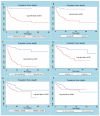Predictors of Death in Patients with Neonatal Sepsis in a Peruvian Hospital
- PMID: 36355884
- PMCID: PMC9697646
- DOI: 10.3390/tropicalmed7110342
Predictors of Death in Patients with Neonatal Sepsis in a Peruvian Hospital
Abstract
Reducing neonatal mortality is a global challenge. This study’s objective was to determine the predictors of mortality in patients with neonatal sepsis. The study was a retrospective cohort study in a Peruvian hospital from January 2014 to April 2022. Neonates diagnosed with sepsis were included. To find predictors of mortality, we used Cox proportional regression models. We evaluated 288 neonates with sepsis; the median birth weight and hospitalization time were 3270 g and seven days, respectively. During follow-up, 18.4% did not survive, and the most common complications were jaundice (35.42%), respiratory distress syndrome (29.51%), and septic shock (12.5%). The most isolated bacteria were Klebsiella pneumoniae. The risk factors associated with higher mortality were prematurity (aHR = 13.92; 95% CI: 1.71−113.51), platelets <150,000 (aHR = 3.64; 1.22−10.88), creatinine greater than 1.10 (aHR = 3.03; 1.09−8.45), septic shock (aHR = 4.41; 2.23−8.74), and admission to IMV (aHR = 5.61; 1.86−16.88), On the other hand, breastfeeding was associated with a lower risk of death (aHR = 0.25; 0.13−0.48). In conclusion, we report a high incidence of death and identify clinical (prematurity, septic shock, admission to IMV) and laboratory characteristics (elevated creatinine and thrombocytopenia) associated with higher mortality in patients with neonatal sepsis. Breastfeeding was a factor associated with survival in these patients.
Keywords: Peru; mortality; neonatal sepsis; newborn; premature; risk factors; sepsis; thrombocytopenia.
Conflict of interest statement
All authors declare no conflict of interest.
Figures
Similar articles
-
Incidence of death and its predictors among neonates admitted with sepsis in referral hospitals, northwest Ethiopia, a prospective cohort study.Front Pediatr. 2023 Apr 13;11:1129924. doi: 10.3389/fped.2023.1129924. eCollection 2023. Front Pediatr. 2023. PMID: 37124184 Free PMC article.
-
Time to death and its predictors among neonates admitted with sepsis in neonatal intensive care unit at comprehensive specialized hospitals in Northeast Ethiopia.Front Pediatr. 2024 Apr 17;12:1366363. doi: 10.3389/fped.2024.1366363. eCollection 2024. Front Pediatr. 2024. PMID: 38711492 Free PMC article.
-
Time to death and its predictors among neonates who were admitted to the neonatal intensive care unit at tertiary hospital, Addis Ababa, Ethiopia: Retrospective follow up study.Front Pediatr. 2022 Aug 29;10:913583. doi: 10.3389/fped.2022.913583. eCollection 2022. Front Pediatr. 2022. PMID: 36120647 Free PMC article.
-
Predictors of Survival Among Preterm Neonates Admitted to Felege Hiwot Comprehensive Specialized Hospital, Northwest Ethiopia.Front Pediatr. 2022 Mar 10;10:800300. doi: 10.3389/fped.2022.800300. eCollection 2022. Front Pediatr. 2022. PMID: 35372165 Free PMC article.
-
Survival Status and Predictors of Mortality among Newborns Admitted with Neonatal Sepsis at Public Hospitals in Ethiopia.Int J Pediatr. 2020 Sep 19;2020:8327028. doi: 10.1155/2020/8327028. eCollection 2020. Int J Pediatr. 2020. PMID: 33029155 Free PMC article.
Cited by
-
Hierarchical Predictors of Mortality in Neonatal Sepsis at Jimma Medical Center, Ethiopia: A Case-Control Study.J Multidiscip Healthc. 2024 Feb 8;17:541-555. doi: 10.2147/JMDH.S446303. eCollection 2024. J Multidiscip Healthc. 2024. PMID: 38348209 Free PMC article.
-
Association between tumor necrosis factor-α gene polymorphism and interleukin-6 level with mortality of neonatal sepsis.Narra J. 2024 Dec;4(3):e1234. doi: 10.52225/narra.v4i3.1234. Epub 2024 Oct 31. Narra J. 2024. PMID: 39816047 Free PMC article.
-
Microbial Pattern of Neonatal Sepsis in the Neonatal Intensive Care Unit of dr. Ramelan Navy Central Hospital.Int J Pediatr. 2024 May 28;2024:6264980. doi: 10.1155/2024/6264980. eCollection 2024. Int J Pediatr. 2024. PMID: 38938686 Free PMC article.
-
Predictors of mortality and severe illness from Escherichia coli sepsis in neonates.J Perinatol. 2024 Dec;44(12):1816-1821. doi: 10.1038/s41372-024-02117-9. Epub 2024 Sep 12. J Perinatol. 2024. PMID: 39266664 Free PMC article.
References
-
- United Nations [(accessed on 25 June 2022)]. Available online: https://www.un-ilibrary.org/content/books/9789210574662.
-
- Rudd K.E., Johnson S.C., Agesa K.M., Shackelford K.A., Tsoi D., Kievlan D.R., Colombara D.V., Ikuta K.S., Kissoon N., Finfer S., et al. Global, regional, and national sepsis incidence and mortality, 1990–2017: Analysis for the Global Burden of Disease Study. Lancet. 2020;395:200–211. doi: 10.1016/S0140-6736(19)32989-7. - DOI - PMC - PubMed
Grants and funding
LinkOut - more resources
Full Text Sources
Miscellaneous



